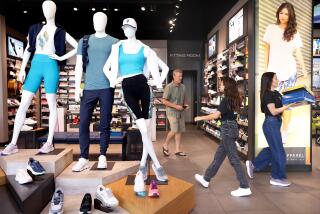New Balance Has Foothold in U.S.
- Share via
LAWRENCE, Mass. — With a flip of the wrist, Phil Vachon, a manufacturing supervisor for New Balance Athletic Shoe Inc., turns a piece of red, black and white cardboard into a box.
Vachon then throws in some tissue and a pair of women’s running shoes, finishing the task in no more than a few seconds.
This week, New Balance will be the last major maker of athletic footwear that still assembles shoes in the U.S. The owners of the Lawrence factory in which Vachon works say advanced machinery, teamwork and patriotism counter the advantage of labor that is one-third as expensive in China.
“We consider ourselves manufacturers when none of our competitors are anymore,” said Chief Executive Jim Davis, 58, who bought the company in 1972. “Though the Boston-based company also has sent jobs overseas, it has increased its U.S. presence. Closely held New Balance employed 1,200 U.S. workers last year, compared with 670 in 1994.
The number of Americans making rubber and plastic footwear shrank to 4,100 from 10,800 in the same period, according to the U.S. Bureau of Labor Statistics.
More jobs are going. Saucony Inc. said in November that it would close its remaining U.S. plant in Bangor, Maine. The last of its 70 employees will lose their jobs this week as the company shifts all production to Asia, making New Balance the one U.S. holdout.
Nike Inc., the largest maker, shifted whole-shoe manufacturing operations to Asia in the early 1990s, spokesman Vada Manager said. Nike still makes air cushions for its shoes in Missouri and Oregon, he said.
New Balance was headed in that direction in the second half of the 1990s, when it increased its share of overseas production to 75% from 45%. Davis, whose goal is to bring that closer to 50%, said the company turned to Asian manufacturers after U.S. factories couldn’t meet demand.
At the same time, it began looking for ways to expand in the U.S. In 1997, the company opened a plant in Norway, Maine, employing an extra 221 people and bringing the number of its U.S. factories to five. A sixth plant in Ontario, owned by Taiwan’s Pou Chen Corp., makes shoes exclusively for New Balance.
The company had 9.6% of the $7.8-billion market for athletic shoes in the U.S. in 2000, according to Sporting Goods Intelligence, an industry newsletter. Nike had 43% of the market, measured on the wholesale level. Reebok International Ltd. had 12% and Adidas-Salomon 11%.
Herbert Spivak, executive vice president of operations at New Balance, said U.S. factories can be justified as long as the cost of making shoes here doesn’t exceed the cost of imports by more than 15%.
New Balance can make up that difference by offering faster delivery to retailers, being closer to its research and development team and having employees devise ways to produce shoes more efficiently.
“We can only do this here if we can get close to the imported cost. That’s what drives our workers,” Spivak said.
More to Read
Inside the business of entertainment
The Wide Shot brings you news, analysis and insights on everything from streaming wars to production — and what it all means for the future.
You may occasionally receive promotional content from the Los Angeles Times.










